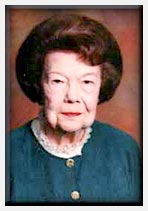End of the Whitey Walker Gang |
|
 Eloise Lane
Eloise Lane
On an icy January morning in 1939, Robert L. May felt like a loser as he was going to his job grinding out catalog copy in the Montgomery Ward building at Chicago. His wife was gravely ill and he was deeply in debt. In the copy department he was asked by the department head to design a booklet to replace the Christmas give-away coloring books that Montgomery Ward had been buying from local peddlers. The proposed booklet would save money for the firm, and the boss thought that it should be an animal story with a character like Ferdinand the Bull. That night May decided that a reindeer would be the appropriate animal for a Christmas story. He wanted the plot to give hope to children by showing that a little reindeer who was teased by other reindeer could turn into an admired leader of Santa's reindeer. As he wondered what could make his little Randolph different from Donner, Blitzen and the other reindeer, suddenly he had the idea of a bright red nose that could shine through fog like a flashlight. The nose would help Santa bring joy to children. May's boss was not pleased with the plan for the booklet and said that a red- nosed reindeer would be a monstrosity, But May had faith in Rudolph and asked a friend in the art department to draw a reindeer with a big red nose that would still be appealing. The boss studied the sketches for a long time before he smiled and told May to put his story in finished form. May finished his booklet in late August and Rudolph's story was rushed into print. About three million copies were given to children for Christmas, and soon the copy office at Montgomery Ward was flooded with enthusiastic letters from grateful parents. In 1949, song publishers began to contact May for permission to use Rudolptf'5 story for a song. A company official said that Rudolph belonged to Montgomery Ward, but Sewell Avery, then chairman of the board of directors, said, "Let Bob May have the copyright." In 1949, "Rudolph the Red-Nosed Reindeer," with lyrics and music by Johnny Marks, was published by St, Nicholas Publishing Company in New York. It was first sung and then popularized by Gene Autry, and now it is sung at Christmas time by children over all the world. In December 1964, "Rudolph the Red-Nosed Reindeer" was featured on T V in a stop-motion animation style dubbed "Animagic" by producers Arthur Rankin, Jr. and Julian Bass. The song has aired annually ever since, finding a new home in 1972 at CBS who gave the song its 40th anniversary telecast on Wednesday, December 1, 2004. In the 1950s and 60s, boys and girls attending Sam Houston Elementary School in Pampa sang a parody based on "Rudolph the Red-~Nosed Reindeer." The parody was about Randolph, the bow-legged cowboy, who had a very shiny gun -- anyone who saw it would turn around and run. The cowboys laughed at Randolph and would not let him join in any poker games. Then one foggy Christmas Eve, the sheriff asked Randolph to use his gun so bright to guide the posse through the night. Then the cowboys shouted out with glee and told Randolph that he would go down in history.

